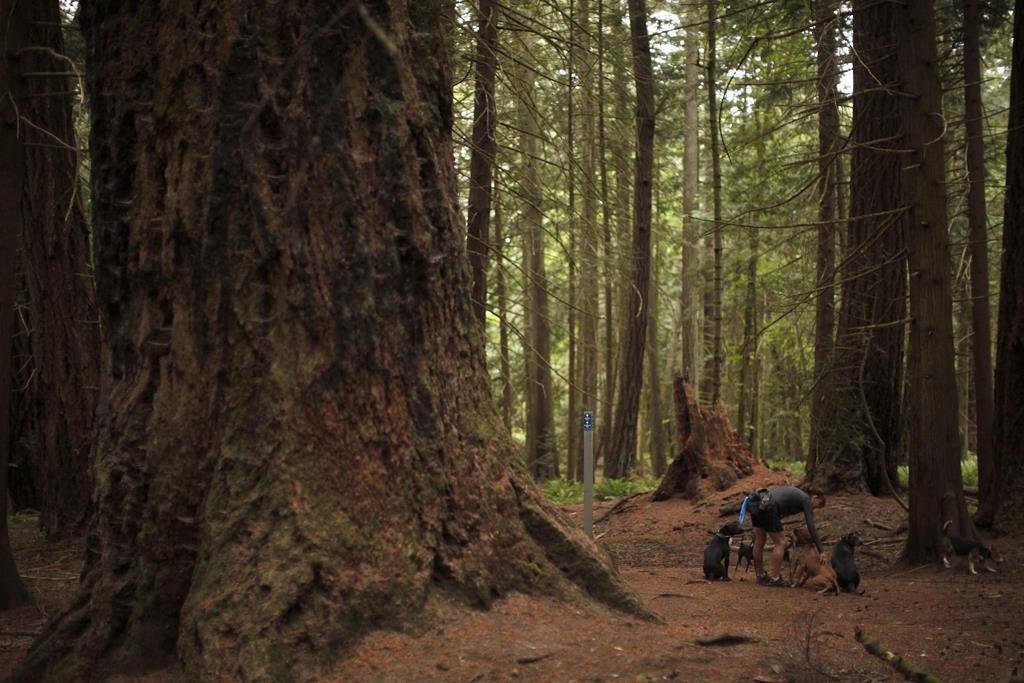An environmental group’s new research report suggests forestry companies are logging old-growth trees in some of the B.C. government’s proposed deferral areas.

Stand.earth’s research team analyzed satellite imagery to determine more than 55,000 hectares of such land is at “imminent risk” of being logged, is currently being logged, or has already been cut.
“Satellite imagery doesn’t lie,” report author Angeline Robertson said in a Tuesday news release.
“If the intent of the province was to pause logging so that a meaningful review of old-growth management can proceed, then this analysis shows that they have failed in the most important aspect — getting the industry to stop logging the most at-risk old growth.”
In a statement, B.C. Forests Minister Katrine Conroy said Stand.earth’s report “misses the forest for the trees,” because it’s misleading the public with claims that a “significant amount” of old-growth has been logged.
“The Ministry of Forests has been monitoring the situation on-the-ground and — in fact — only around 0.3 per cent of the proposed deferral areas have been harvested since November 2021 when engagements with First Nations started,” she wrote.
“After decades of neglect, we are taking better care of our oldest and rarest forests for future generations.”

According to the provincial government, one-third of B.C.’s 11.1 million hectares of old-growth forest is protected, with old-growth harvesting having decreased by 40 per cent in the past five years.
Logging has been deferred — temporarily suspended — on nearly 1.7 million hectares in partnership with First Nations to protect the “most ancient and rarest forests,” while work on a new, sustainable forestry strategy is underway, according to Conroy.
In November last year, the province released findings from an independent Old Growth Technical Advisory Panel, which identified 2.6 million hectares of unprotected, at-risk old-growth that should be prioritized for deferrals in B.C.
In December, it further disclosed that some 50,000 hectares overlap priority deferral areas with previously approved cutting permits.
Stand.earth’s report suggests 1,600 hectares of forest in those proposed deferral areas in four sample areas were logged between March of 2021 and 2022. Forty-three per cent, it added, were harvested after the province’s November announcement, and 94 per cent of the land logged was classified as “prioritized big-treed old growth forest.”

Get breaking National news
The research group studied satellite imagery of forests in the Omineca, Cariboo, West Coast and Kootenay-Boundary natural resource regions, which have a “high degree of overlap” between candidate deferral areas and approved cut blocks, compared to other regions.
Canfor, West Fraser, Sinclar Group, Interfor, Weyerhaeuser, and Western Forest Products represent the “majority of the threat,” the report claims, with all but Weyerhaeuser having logged in an old-growth area at risk.
Global News reached out to all six companies for comment.

In a statement, Joyce Wagenaar of West Fraser said the company only harvests in “permitted areas” after consultation is complete with local First Nations.
“All harvest activity West Fraser undertakes is subject to government permitting approvals, consultations with Indigenous Nations, and is fully compliant with provincial laws, regulations and protection orders,” she wrote.
Babita Khunkun of Western Forest Products noted that final decisions on proposed, temporary deferral areas have not yet been made by provincial and First Nations governments.
“We look forward to continuing to actively work with First Nations to advance sustainable forest management through respectful collaborative approaches, using local information and modern advanced forest inventories considering all ecological and cultural values, including ensuring there are old forests in perpetuity,” Khunkhun wrote in an email.
Michelle Ward of Canfor said the company follows “rigorous environmental standards and all provincial and federal laws.”
“As a company, we also greatly respect the rights and title of Indigenous Nations on whose traditional territories we operate and their valued roles in stewarding the forests,” Ward wrote.
“We are focused on working closely with the applicable Indigenous Nations to review the proposed old growth deferrals and seek their input into our proposed harvesting. We also continue to work closely with government as the process moves forward.”

In June, the Union of BC Indian Chiefs (UBCIC) called on the B.C. government to immediately defer logging in all proposed old-growth areas, in addition to areas identified by First Nations.
It renewed that call on Tuesday, in keeping with the UN Declaration on the Rights of Indigenous Peoples, which enshrines free, prior and informed consent.
“The province has continued to let logging of old growth happen, while publishing glossy images of old growth trees to spread the message that they are taking action,” Kúkpi7 Judy Wilson and UBCIC secretary-treasurer said in a news release.
“It is simply not enough — we are looking to the B.C. NDP to take immediate action, particularly under a new leader.”
Conroy said Tuesday that a number of First Nations have indicated they do not support the deferrals proposed by the provincial government.
“Government has always been clear that we will respect their decisions and will not be imposing deferrals unilaterally. Logging will proceed on their territories,” she said.
According to the province, logging is not occurring on land where First Nations have agreed to deferrals, including in cases where cutting permits were already approved. The only exception, it said, is in areas that did not meet the technical advisory panel’s criteria for old-growth.

Robertson, the report author, claims all of the areas currently protected by deferrals in B.C. were either in areas controlled by the provincial government, or areas that weren’t at risk of logging.
“I hope that they realize they cannot keep tricking the constituency into thinking that progress is being made when it’s not, and getting part of the way on the low-hanging fruit of this process is not going to be satisfactory,” she told Global News.
The report also accuses the B.C. government of failing to consider old-growth losses that stem from oil and gas development, rather than solely logging companies, “suggesting that the government lacks a comprehensive approach and cumulative impact assessment for old growth forest management.”








Comments